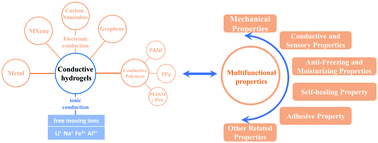Multifunctional conductive hydrogels and their applications as smart wearable devices
Abstract
Recently, hydrogel-based conductive materials and their applications as smart wearable devices have been paid tremendous attention due to their high stretchability, flexibility, and excellent biocompatibility. Compared with single functional conductive hydrogels, multifunctional conductive hydrogels are more advantageous to match various demands for practical applications. This review focuses on multifunctional conductive hydrogels applied for smart wearable devices. Representative strategies for conduction of hydrogels are discussed firstly: (1) electronic conduction based on the conductive fillers and (2) ionic conduction based on charged ions. Then, the common and intensive research on multiple functionalities of conductive hydrogels, such as mechanical properties, conductive and sensory properties, anti-freezing and moisturizing properties, and adhesion and self-healing properties is presented. The applications of multifunctional conductive hydrogels such as in human motion sensors, sensory skins, and personal healthcare diagnosis are provided in the third part. Finally, we offer our perspective on open challenges and future areas of interest for multifunctional conductive hydrogels used as smart wearable devices.

- This article is part of the themed collections: Journal of Materials Chemistry B Recent Review Articles and Journal of Materials Chemistry B HOT Papers


 Please wait while we load your content...
Please wait while we load your content...